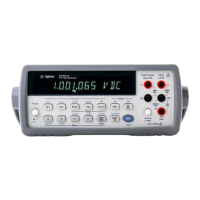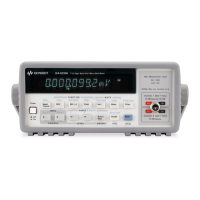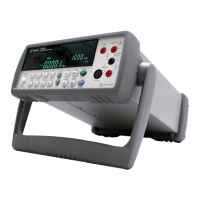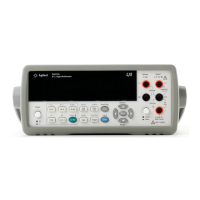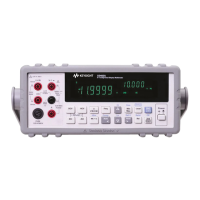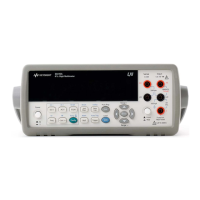Chapter 3 Configuring for Measurements 61
For DC or ohms measurements (and analog AC measurements), resolution
is determined by the A/D converter's integration time. When you specify a
resolution, you are actually indirectly specifying an integration time. Since
the APER or NPLC command can also specify an integration time, an
interaction occurs when you specify resolution as follows:
• If you send the APER or NPLC command before specifying resolution, the
multimeter satisfies the command that specifies greater resolution (more
integration time).
• If you send the APER or NPLC command after specifying resolution. the
multimeter uses the integration time specified by the APER or NPLC
command, and any previously specified resolution is ignored.
When to Specify Resolution For DC or ohms measurements, you should specify resolution when the
resolution provided by the NPLC or APER command is not sufficient. For
example, in the following program, line 10 specifies 1 PLC of integration
time which provides 60dB of NMR and 7½ digits of resolution. This produces
an actual resolution of 1 µV on the 10V range. For this application, 100nV
of resolution is required with a max._input of 10V. The preceding equation
produces a %_resolution parameter of 0.000001 (1E-6). This is specified in
line 20.
10 OUTPUT 722;"NPLC 1"
20 OUTPUT 722;"DCV 10, 1E-6"
30 END
Autozero The autozero function ensures that any offset errors internal to the multimeter
are nulled from subsequent DC or ohms measurements. The autozero
function is controlled using the AZERO command. With AZERO ON, the
multimeter internally disconnects the input signal and makes a zero reading
following every measurement. It then algebraically subtracts the zero reading
from the preceding measurement. With AZERO OFF or ONCE, the
multimeter takes one zero reading and algebraically subtracts this from
subsequent readings. After you execute AZERO OFF or AZERO ONCE, the
multimeter takes the autozero measurement when the first trigger arm event
occurs for all events except TARM EXT which causes an autozero
measurement when the TARM EXT command is executed. (The trigger arm
event is discussed in Chapter 4.) The autozero measurement is updated
whenever the measurement function, range, or integration time is changed
(this update is made when the trigger arm event occurs or TARM EXT is
executed). In the power-on/PRESET NORM state, AZERO is set to ON. You
can change it by sending:
OUTPUT 722;"AZERO OFF"
Note You should leave autozero on (AZERO ON command) for 4-wire ohms
measurements. If you must disable autozero (AZERO OFF or ONCE), be
sure to make all measurement connections before disabling autozero and
ensure that the lead resistance will not change. If you disable autozero
before making the 4-wire connections, or if you have a varying lead
resistance with autozero disabled (such as when scanning), you may get

